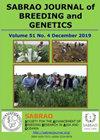藜麦的耐盐性(藜麦野生)基因型对萌发和苗期nacl浓度升高的影响
IF 1.6
Q3 PLANT SCIENCES
引用次数: 0
摘要
在发芽和幼苗阶段评估藜麦基因型的耐盐性是植物育种的先决条件。因此,在实验室和温室条件下对19种不同盐度水平的藜麦基因型进行了发芽和幼苗期的对照研究。本研究旨在通过基于随机完全区组设计的三次重复因子试验,确定发芽和苗期对高盐度水平最耐受的基因型,并确定与耐盐性相关的性状。使用的四种盐度溶液分别为0(对照)、3000、6000和9000 ppm NaCl。随着NaCl浓度的增加,除平均发芽时间显著增加外,其他性状均逐渐显著降低。在3000、6000和9000 ppm NaCl盐胁迫下,将19个基因型根据耐盐指数(STI)分为耐盐、中等耐盐和敏感3类。在所有研究的盐胁迫条件下,四种最耐盐的藜麦基因型是Rainbow-2、Ql3、RH和KvlSRA2。在3000 ppm下,STI与幼苗长、根长、幼苗鲜重、幼苗活力指数I和幼苗活力指数II的相关性最强;在6000 ppm条件下,发芽率、发芽速度指数、成苗程度、根长、幼苗鲜重、幼苗活力指数II;在9000 ppm盐度水平下,茎长和幼苗活力指数I的变化显著。在所有盐胁迫浓度下,与STI相关性强、遗传力估计高、遗传进展预期高、表型和基因型变异性广的性状是幼苗干重、幼苗鲜重、幼苗活力指数II和幼苗萌发速度指数;推荐作为藜麦发芽期和幼苗期耐盐性的选择标准。本文章由计算机程序翻译,如有差异,请以英文原文为准。
SALINITY TOLERANCE OF QUINOA (CHENOPODIUM QUINOA WILLD.) GENOTYPES TO ELEVATED NACL CONCENTRATIONS AT GERMINATION AND SEEDLING STAGES
Evaluating quinoa genotypes for salinity tolerance at germination and seedling stages is a prerequisite for plant breeders. Thus, the scrutiny of 19 quinoa genotypes at different salinity levels under controlled laboratory and greenhouse conditions occurred at the germination and seedling stages. This study aimed to identify the most tolerant genotypes to elevated salinity levels at germination and seedling stages and to determine the traits of a robust association with salinity tolerance using a factorial experiment based on a randomized complete block design in three replications. The four salinity solutions used were zero (control), 3000, 6000, and 9000 ppm NaCl. Increasing concentrations of NaCl caused a gradual and significant decrease for all studied traits except mean germination time, which significantly increased. At all salinity-stress levels (3000, 6000, and 9000 ppm NaCl), the studied 19 genotypes underwent classification based on their salinity tolerance index (STI) into three categories, i.e., tolerant, moderately tolerant, and sensitive. The four most salinitytolerant quinoa genotypes under all studied salinity-stress conditions were Rainbow-2, Ql3, RH, and KvlSRA2. The strongest correlations were between STI and each of seedling length, root length, seedling fresh weight, seedling vigor index I, and seedling vigor index II under 3000 ppm; germination percentage, speed germination index, seedling extent, root length, seedling fresh weight, and seedling vigor index II under 6000 ppm; and shoot length and seedling vigor index I under 9000 ppm salinity concentration level. Traits showing sturdy correlations with STI, high heritability estimates, high expected genetic advance, and wide phenotypic and genotypic variability were seedling dry weight, seedling fresh weight, seedling vigor index II, and speed germination index at all salinity stress concentrations; they are recommendable as selection criteria for salinity tolerance in quinoa at germination and seedling stages.
求助全文
通过发布文献求助,成功后即可免费获取论文全文。
去求助
来源期刊

Sabrao Journal of Breeding and Genetics
农林科学-奶制品与动物科学
CiteScore
1.90
自引率
50.00%
发文量
63
期刊介绍:
The SABRAO Journal of Breeding and Genetics is an international journal of plant breeding and genetics research and was first published in 1969. It is the official publication of the Society for the Advancement of Breeding Research in Asia and Oceania (SABRAO).
Its objectives are to: promote the international exchange of research information on plant breeding and genetics, by describing new research findings, or ideas of a basic or practical nature; and be a medium for the exchange of ideas and news regarding members of the Society.
The Journal gives priority to articles that are of direct relevance to plant breeders and with emphasis on the Asian region. Invited for publication are research articles, short communications, methods, reviews, commentaries, and opinion articles. Scientific contributions are refereed and edited to international standards.
The journal publishes articles for SABRAO members mainly. The Journal preferred strongly that at least one author should be a current member of the Society. Non-members may also publish in the journal.
 求助内容:
求助内容: 应助结果提醒方式:
应助结果提醒方式:


